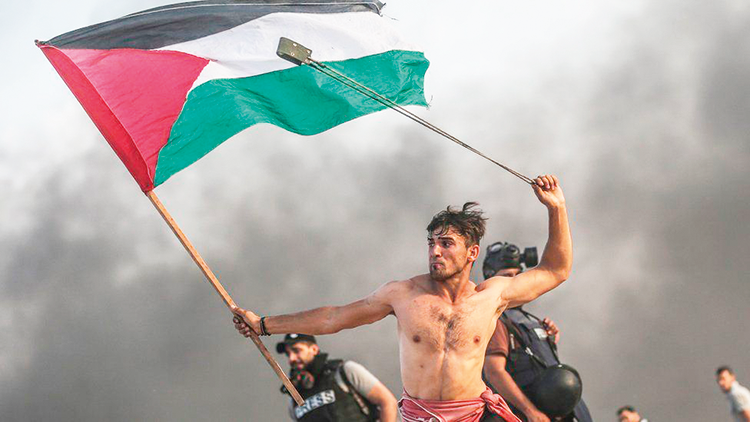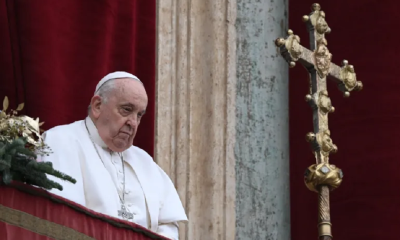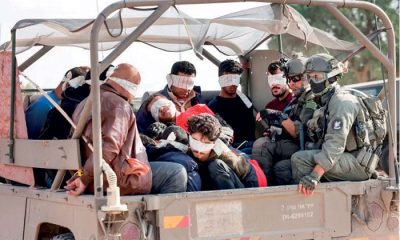Features
Discussing Palestine in Sri Lanka

By Uditha Devapriya
“She vigorously defended apartheid as a necessary bulwark against black domination and the communism that engulfed her native Yugoslavia. [She]… thought Africans inferior to other human beings and not entitled to be treated as equals. I asked if Hitler hadn’t said the same thing about her as a Jew. She called a halt to the conversation.”
Chris McGreal, The Guardian, February 7, 2006
Last Wednesday, January 31, the Centre for Progressive Politics & Policy held its inaugural webinar on Sri Lanka’s response to South Africa’s case against Israel. Moderated by Saroj Pathirana, it featured two women’s rights activists, Shreen Saroor and Piyumi Wattuhewa, alongside Kalana Senaratne, Hejaaz Hizbullah, and Dayan Jayatilleka. The latter’s inclusion was particularly refreshing; he should be one of the main voices in discussions like this, even if for some reason he never seems to get featured in them.
The participants brought out some interesting perspectives on the ruling situation. While Senaratne reflected on how the Global South has taken over the moral high ground on human rights issues, Hizbullah, a victim of anti-terror legislation in Sri Lanka, dwelt on how the war in Gaza sheds light on the West’s racist attitudes against Muslims and the Israeli model’s acceptance by Sinhala nationalists in Sri Lanka and abroad. Saroor dwelt on the parallels between the Gaza conflict and the separatist conflict in Sri Lanka, while Wattuhewa brought out a feminist youth angle, emphasising the need for broad solidarity on Gaza.
Jayatilleka began his intervention by recalling Palestine’s bid for membership at UNESCO, where he served as Sri Lanka’s Permanent Delegate, in Paris, from 2011 to 2013. The vote came up for discussion at the 193rd UN General Conference. As expected, Western countries led by the US tried to stall it.
Hillary Clinton – who recently took to Twitter to lament Margot Robbie’s exclusion from the Oscars, but has yet to tweet about or share images of what Palestinian women are going through in Gaza – asked UNESCO to rethink its decision, while a Republican Senator threatened to cut US funding to that agency.
In hindsight, the latter threat seems to have been prescient, with a Democratic government now cutting funding to the UN agency for refugees, on largely unsubstantiated allegations of UN staff collaborating with Hamas. Back then, however, sanity prevailed, and in a broad show of Global Southern unity, Palestine’s bid succeeded, with a majority (107-14) which surprised if not shocked the West. Coming 12 years before the current war, it was an early example of the possibilities of Global Southernism, of the sort that, as Senaratne implied in his presentation, appears to be emanating from Africa.
Africa’s recent interventions on these fronts have not been examined properly, especially by Western analysts who dismiss it as a passive participant in global politics. South Africa’s case and Gambia’s interventions in the conflict are, in that sense, not just commendable; they are also indicative of a broader shift in the Global South. In Asia, countries like India have been ambivalent, at best, with their stance on Israel, and the Sri Lankan government seems to be of two minds when it comes to Gaza. Africa, by contrast, has been much more steadfast and consistent in their support of the Palestinians.
When considering Sri Lanka’s response to the South Africa ruling, a distinction must be drawn between the people and the government. The latter, for all intents and purposes, is trying an intriguing balancing act, supporting the Global South’s push for a humanitarian ceasefire while sending our youth to work in Israel. While it remains to be seen how the regime will achieve this balance, Sri Lankans, particularly the youth, are calling for a more ethical stance. Moreover, as one participant noted, the Palestinian Ambassador called on and commended the likes of Mahinda Rajapaksa, but had nothing to say to, or about, the President, even though the latter is amplifying calls for a ceasefire abroad.
Sri Lankan youth are overwhelmingly siding with Palestine because they identify Palestine, and the African countries that have called for an end to Israeli atrocities in Gaza, as the marginalised. Yet much of the Global North has framed Israel as the smaller, defenceless power that is being encircled by stronger states and needs protection by the West. Though Joe Biden has imposed sanctions on Israeli settlers, and David Cameron speaks about a Palestinian State, risking backlash from their party colleagues, the US and UK have done very little to prevent the bloodbath unfolding in the region.
In that context, Hizbullah’s point about Islamophobia and its bearing on Israel and Sri Lanka is very pertinent. He noted, correctly, that many Sinhala nationalists have sided with Israel, seeing Hamas as an extension of the kind of Islamic fundamentalism they associate with almost all Muslims in Sri Lanka. In other words, they have accepted Israel’s response. The parallels Saroor brought up between the conflict there and the conflict shed light on this further, though, as Hizbullah acknowledged, the figurehead of Sinhala nationalist politics in Sri Lanka, Mahinda Rajapaksa, is seen as a hero by Palestine.
Both Saroor and Hizbullah are brave, courageous critics of all forms of chauvinism; Saroor in particular noted her defiance of the LTTE. In that sense, and adding to what they said, I think we need to note that, inasmuch as Sinhala nationalists sought common ground with Israel’s “response” to Muslim “terrorists”, Tamil nationalists once identified with the Israeli model as well. Though Tamil nationalist outfits set up links with Palestinian resistance leaders like George Habash, the rise of the LTTE put an end to hopes of a rapprochement between these groups. In Sri Lanka, hence, Palestine became a lost cause.
This dovetails with another issue. Historically, Sinhala and Tamil nationalist groups in Sri Lanka both identified themselves as victims: of British colonialism in the case of Sinhala nationalists, of Sinhala chauvinism in the case of Tamil nationalists. Yet they adopted the viewpoint of the groups that brutalised them when they rose to power. Seeing themselves as the oppressed, they turned oppressor the minute they got the chance.
In a way, that parallels the tragedy of the Jewish people as well. Following the Second World War, the Jewish diaspora had the unprecedented chance of turning into a voice for the voiceless, of championing causes like decolonisation and anti-racism. Yet its leaders ended up hobnobbing with pariah, authoritarian, and racist regimes: the Israeli government, for instance, supported apartheid South Africa, while Jewish migrants and Holocaust survivors who settled there – with the exception of progressive liberals like Helen Suzman, a secular Jew who associated with Nelson Mandela – sided with the White regime.
For a while, marginalised communities in the West, like African Americans during the Civil Rights Movement in the US, expressed some sympathy for Zionism and identified the Jewish people as kindred spirits. But that was another world. Following the Six-Day War in 1967, Israel’s treatment of Palestinians and its support for the West’s forever wars, including in Vietnam, began draining the country of whatever support it had got from these groups. This dovetailed with its fading support within the Global South: while S. W. R. D. Bandaranaike could champion the Palestinian cause and defend Israel’s right to exist in the 1950s, by the 1970s and 1980s such attitudes had faded away.
The Israeli government has only itself to blame for this, and that applies to all parties and politicians there. Those who argue that it became racist and genocidal after the rise of Likud, the right-wing party that nurtured Benjamin Netanyahu, forget that the Labour Party was in power in the 1950s. However more progressive the Party may have been on domestic and economic issues, it was hardly less complicit in the marginalisation and brutalisation of the Palestinians. Though promoting democracy at home, it stifled dissent abroad, turning any criticism of the country into a cover for anti-Semitism. In the end it lost credibility in the very regions which would have been in its interest to have been allied with.
It is in light of these historical developments that Sri Lanka’s response to the ICJ ruling must be viewed, considered, and debated. For some the ruling does not go far enough – it does not, for instance, call for an immediate ceasefire – while for others it remains a landmark. However one may view the ruling, in Sri Lanka there is a clear and broad show of support for Palestine and the people of Gaza. The vast majority of Sri Lankans, particularly its youth, do not consider Palestine negotiable. In Sri Lanka, simply put, it is not up for debate, but for discussion. And as the CPPP webinar made it clear, there are many perspectives that must be factored in, and incorporated, when discussing it.
Note: The Centre for Progressive Politics & Policy is a research collective that focuses on Governance, Political Institutions, Freedom of Expression, Youth and Gender, Reconciliation, and Poverty. It can be accessed at . www.muragala.lk.
Uditha Devapriya is a writer, researcher, and analyst based in Sri Lanka who contributes to a number of publications on topics such as history, art and culture, politics, and foreign policy. He can be reached at .udakdev1@gmail.com.
Features
The heart-friendly health minister

by Dr Gotabhya Ranasinghe
Senior Consultant Cardiologist
National Hospital Sri Lanka
When we sought a meeting with Hon Dr. Ramesh Pathirana, Minister of Health, he graciously cleared his busy schedule to accommodate us. Renowned for his attentive listening and deep understanding, Minister Pathirana is dedicated to advancing the health sector. His openness and transparency exemplify the qualities of an exemplary politician and minister.
Dr. Palitha Mahipala, the current Health Secretary, demonstrates both commendable enthusiasm and unwavering support. This combination of attributes makes him a highly compatible colleague for the esteemed Minister of Health.
Our discussion centered on a project that has been in the works for the past 30 years, one that no other minister had managed to advance.
Minister Pathirana, however, recognized the project’s significance and its potential to revolutionize care for heart patients.
The project involves the construction of a state-of-the-art facility at the premises of the National Hospital Colombo. The project’s location within the premises of the National Hospital underscores its importance and relevance to the healthcare infrastructure of the nation.
This facility will include a cardiology building and a tertiary care center, equipped with the latest technology to handle and treat all types of heart-related conditions and surgeries.
Securing funding was a major milestone for this initiative. Minister Pathirana successfully obtained approval for a $40 billion loan from the Asian Development Bank. With the funding in place, the foundation stone is scheduled to be laid in September this year, and construction will begin in January 2025.
This project guarantees a consistent and uninterrupted supply of stents and related medications for heart patients. As a result, patients will have timely access to essential medical supplies during their treatment and recovery. By securing these critical resources, the project aims to enhance patient outcomes, minimize treatment delays, and maintain the highest standards of cardiac care.
Upon its fruition, this monumental building will serve as a beacon of hope and healing, symbolizing the unwavering dedication to improving patient outcomes and fostering a healthier society.We anticipate a future marked by significant progress and positive outcomes in Sri Lanka’s cardiovascular treatment landscape within the foreseeable timeframe.
Features
A LOVING TRIBUTE TO JESUIT FR. ALOYSIUS PIERIS ON HIS 90th BIRTHDAY

by Fr. Emmanuel Fernando, OMI
Jesuit Fr. Aloysius Pieris (affectionately called Fr. Aloy) celebrated his 90th birthday on April 9, 2024 and I, as the editor of our Oblate Journal, THE MISSIONARY OBLATE had gone to press by that time. Immediately I decided to publish an article, appreciating the untiring selfless services he continues to offer for inter-Faith dialogue, the renewal of the Catholic Church, his concern for the poor and the suffering Sri Lankan masses and to me, the present writer.
It was in 1988, when I was appointed Director of the Oblate Scholastics at Ampitiya by the then Oblate Provincial Fr. Anselm Silva, that I came to know Fr. Aloy more closely. Knowing well his expertise in matters spiritual, theological, Indological and pastoral, and with the collaborative spirit of my companion-formators, our Oblate Scholastics were sent to Tulana, the Research and Encounter Centre, Kelaniya, of which he is the Founder-Director, for ‘exposure-programmes’ on matters spiritual, biblical, theological and pastoral. Some of these dimensions according to my view and that of my companion-formators, were not available at the National Seminary, Ampitiya.
Ever since that time, our Oblate formators/ accompaniers at the Oblate Scholasticate, Ampitiya , have continued to send our Oblate Scholastics to Tulana Centre for deepening their insights and convictions regarding matters needed to serve the people in today’s context. Fr. Aloy also had tried very enthusiastically with the Oblate team headed by Frs. Oswald Firth and Clement Waidyasekara to begin a Theologate, directed by the Religious Congregations in Sri Lanka, for the contextual formation/ accompaniment of their members. It should very well be a desired goal of the Leaders / Provincials of the Religious Congregations.
Besides being a formator/accompanier at the Oblate Scholasticate, I was entrusted also with the task of editing and publishing our Oblate journal, ‘The Missionary Oblate’. To maintain the quality of the journal I continue to depend on Fr. Aloy for his thought-provoking and stimulating articles on Biblical Spirituality, Biblical Theology and Ecclesiology. I am very grateful to him for his generous assistance. Of late, his writings on renewal of the Church, initiated by Pope St. John XX111 and continued by Pope Francis through the Synodal path, published in our Oblate journal, enable our readers to focus their attention also on the needed renewal in the Catholic Church in Sri Lanka. Fr. Aloy appreciated very much the Synodal path adopted by the Jesuit Pope Francis for the renewal of the Church, rooted very much on prayerful discernment. In my Religious and presbyteral life, Fr.Aloy continues to be my spiritual animator / guide and ongoing formator / acccompanier.
Fr. Aloysius Pieris, BA Hons (Lond), LPh (SHC, India), STL (PFT, Naples), PhD (SLU/VC), ThD (Tilburg), D.Ltt (KU), has been one of the eminent Asian theologians well recognized internationally and one who has lectured and held visiting chairs in many universities both in the West and in the East. Many members of Religious Congregations from Asian countries have benefited from his lectures and guidance in the East Asian Pastoral Institute (EAPI) in Manila, Philippines. He had been a Theologian consulted by the Federation of Asian Bishops’ Conferences for many years. During his professorship at the Gregorian University in Rome, he was called to be a member of a special group of advisers on other religions consulted by Pope Paul VI.
Fr. Aloy is the author of more than 30 books and well over 500 Research Papers. Some of his books and articles have been translated and published in several countries. Among those books, one can find the following: 1) The Genesis of an Asian Theology of Liberation (An Autobiographical Excursus on the Art of Theologising in Asia, 2) An Asian Theology of Liberation, 3) Providential Timeliness of Vatican 11 (a long-overdue halt to a scandalous millennium, 4) Give Vatican 11 a chance, 5) Leadership in the Church, 6) Relishing our faith in working for justice (Themes for study and discussion), 7) A Message meant mainly, not exclusively for Jesuits (Background information necessary for helping Francis renew the Church), 8) Lent in Lanka (Reflections and Resolutions, 9) Love meets wisdom (A Christian Experience of Buddhism, 10) Fire and Water 11) God’s Reign for God’s poor, 12) Our Unhiddden Agenda (How we Jesuits work, pray and form our men). He is also the Editor of two journals, Vagdevi, Journal of Religious Reflection and Dialogue, New Series.
Fr. Aloy has a BA in Pali and Sanskrit from the University of London and a Ph.D in Buddhist Philosophy from the University of Sri Lankan, Vidyodaya Campus. On Nov. 23, 2019, he was awarded the prestigious honorary Doctorate of Literature (D.Litt) by the Chancellor of the University of Kelaniya, the Most Venerable Welamitiyawe Dharmakirthi Sri Kusala Dhamma Thera.
Fr. Aloy continues to be a promoter of Gospel values and virtues. Justice as a constitutive dimension of love and social concern for the downtrodden masses are very much noted in his life and work. He had very much appreciated the commitment of the late Fr. Joseph (Joe) Fernando, the National Director of the Social and Economic Centre (SEDEC) for the poor.
In Sri Lanka, a few religious Congregations – the Good Shepherd Sisters, the Christian Brothers, the Marist Brothers and the Oblates – have invited him to animate their members especially during their Provincial Congresses, Chapters and International Conferences. The mainline Christian Churches also have sought his advice and followed his seminars. I, for one, regret very much, that the Sri Lankan authorities of the Catholic Church –today’s Hierarchy—- have not sought Fr.
Aloy’s expertise for the renewal of the Catholic Church in Sri Lanka and thus have not benefited from the immense store of wisdom and insight that he can offer to our local Church while the Sri Lankan bishops who governed the Catholic church in the immediate aftermath of the Second Vatican Council (Edmund Fernando OMI, Anthony de Saram, Leo Nanayakkara OSB, Frank Marcus Fernando, Paul Perera,) visited him and consulted him on many matters. Among the Tamil Bishops, Bishop Rayappu Joseph was keeping close contact with him and Bishop J. Deogupillai hosted him and his team visiting him after the horrible Black July massacre of Tamils.
Features
A fairy tale, success or debacle

Sri Lanka-Singapore Free Trade Agreement
By Gomi Senadhira
senadhiragomi@gmail.com
“You might tell fairy tales, but the progress of a country cannot be achieved through such narratives. A country cannot be developed by making false promises. The country moved backward because of the electoral promises made by political parties throughout time. We have witnessed that the ultimate result of this is the country becoming bankrupt. Unfortunately, many segments of the population have not come to realize this yet.” – President Ranil Wickremesinghe, 2024 Budget speech
Any Sri Lankan would agree with the above words of President Wickremesinghe on the false promises our politicians and officials make and the fairy tales they narrate which bankrupted this country. So, to understand this, let’s look at one such fairy tale with lots of false promises; Ranil Wickremesinghe’s greatest achievement in the area of international trade and investment promotion during the Yahapalana period, Sri Lanka-Singapore Free Trade Agreement (SLSFTA).
It is appropriate and timely to do it now as Finance Minister Wickremesinghe has just presented to parliament a bill on the National Policy on Economic Transformation which includes the establishment of an Office for International Trade and the Sri Lanka Institute of Economics and International Trade.
Was SLSFTA a “Cleverly negotiated Free Trade Agreement” as stated by the (former) Minister of Development Strategies and International Trade Malik Samarawickrama during the Parliamentary Debate on the SLSFTA in July 2018, or a colossal blunder covered up with lies, false promises, and fairy tales? After SLSFTA was signed there were a number of fairy tales published on this agreement by the Ministry of Development Strategies and International, Institute of Policy Studies, and others.
However, for this article, I would like to limit my comments to the speech by Minister Samarawickrama during the Parliamentary Debate, and the two most important areas in the agreement which were covered up with lies, fairy tales, and false promises, namely: revenue loss for Sri Lanka and Investment from Singapore. On the other important area, “Waste products dumping” I do not want to comment here as I have written extensively on the issue.
1. The revenue loss
During the Parliamentary Debate in July 2018, Minister Samarawickrama stated “…. let me reiterate that this FTA with Singapore has been very cleverly negotiated by us…. The liberalisation programme under this FTA has been carefully designed to have the least impact on domestic industry and revenue collection. We have included all revenue sensitive items in the negative list of items which will not be subject to removal of tariff. Therefore, 97.8% revenue from Customs duty is protected. Our tariff liberalisation will take place over a period of 12-15 years! In fact, the revenue earned through tariffs on goods imported from Singapore last year was Rs. 35 billion.
The revenue loss for over the next 15 years due to the FTA is only Rs. 733 million– which when annualised, on average, is just Rs. 51 million. That is just 0.14% per year! So anyone who claims the Singapore FTA causes revenue loss to the Government cannot do basic arithmetic! Mr. Speaker, in conclusion, I call on my fellow members of this House – don’t mislead the public with baseless criticism that is not grounded in facts. Don’t look at petty politics and use these issues for your own political survival.”
I was surprised to read the minister’s speech because an article published in January 2018 in “The Straits Times“, based on information released by the Singaporean Negotiators stated, “…. With the FTA, tariff savings for Singapore exports are estimated to hit $10 million annually“.
As the annual tariff savings (that is the revenue loss for Sri Lanka) calculated by the Singaporean Negotiators, Singaporean $ 10 million (Sri Lankan rupees 1,200 million in 2018) was way above the rupees’ 733 million revenue loss for 15 years estimated by the Sri Lankan negotiators, it was clear to any observer that one of the parties to the agreement had not done the basic arithmetic!
Six years later, according to a report published by “The Morning” newspaper, speaking at the Committee on Public Finance (COPF) on 7th May 2024, Mr Samarawickrama’s chief trade negotiator K.J. Weerasinghehad had admitted “…. that forecasted revenue loss for the Government of Sri Lanka through the Singapore FTA is Rs. 450 million in 2023 and Rs. 1.3 billion in 2024.”
If these numbers are correct, as tariff liberalisation under the SLSFTA has just started, we will pass Rs 2 billion very soon. Then, the question is how Sri Lanka’s trade negotiators made such a colossal blunder. Didn’t they do their basic arithmetic? If they didn’t know how to do basic arithmetic they should have at least done their basic readings. For example, the headline of the article published in The Straits Times in January 2018 was “Singapore, Sri Lanka sign FTA, annual savings of $10m expected”.
Anyway, as Sri Lanka’s chief negotiator reiterated at the COPF meeting that “…. since 99% of the tariffs in Singapore have zero rates of duty, Sri Lanka has agreed on 80% tariff liberalisation over a period of 15 years while expecting Singapore investments to address the imbalance in trade,” let’s turn towards investment.
Investment from Singapore
In July 2018, speaking during the Parliamentary Debate on the FTA this is what Minister Malik Samarawickrama stated on investment from Singapore, “Already, thanks to this FTA, in just the past two-and-a-half months since the agreement came into effect we have received a proposal from Singapore for investment amounting to $ 14.8 billion in an oil refinery for export of petroleum products. In addition, we have proposals for a steel manufacturing plant for exports ($ 1 billion investment), flour milling plant ($ 50 million), sugar refinery ($ 200 million). This adds up to more than $ 16.05 billion in the pipeline on these projects alone.
And all of these projects will create thousands of more jobs for our people. In principle approval has already been granted by the BOI and the investors are awaiting the release of land the environmental approvals to commence the project.
I request the Opposition and those with vested interests to change their narrow-minded thinking and join us to develop our country. We must always look at what is best for the whole community, not just the few who may oppose. We owe it to our people to courageously take decisions that will change their lives for the better.”
According to the media report I quoted earlier, speaking at the Committee on Public Finance (COPF) Chief Negotiator Weerasinghe has admitted that Sri Lanka was not happy with overall Singapore investments that have come in the past few years in return for the trade liberalisation under the Singapore-Sri Lanka Free Trade Agreement. He has added that between 2021 and 2023 the total investment from Singapore had been around $162 million!
What happened to those projects worth $16 billion negotiated, thanks to the SLSFTA, in just the two-and-a-half months after the agreement came into effect and approved by the BOI? I do not know about the steel manufacturing plant for exports ($ 1 billion investment), flour milling plant ($ 50 million) and sugar refinery ($ 200 million).
However, story of the multibillion-dollar investment in the Petroleum Refinery unfolded in a manner that would qualify it as the best fairy tale with false promises presented by our politicians and the officials, prior to 2019 elections.
Though many Sri Lankans got to know, through the media which repeatedly highlighted a plethora of issues surrounding the project and the questionable credentials of the Singaporean investor, the construction work on the Mirrijiwela Oil Refinery along with the cement factory began on the24th of March 2019 with a bang and Minister Ranil Wickremesinghe and his ministers along with the foreign and local dignitaries laid the foundation stones.
That was few months before the 2019 Presidential elections. Inaugurating the construction work Prime Minister Ranil Wickremesinghe said the projects will create thousands of job opportunities in the area and surrounding districts.
The oil refinery, which was to be built over 200 acres of land, with the capacity to refine 200,000 barrels of crude oil per day, was to generate US$7 billion of exports and create 1,500 direct and 3,000 indirect jobs. The construction of the refinery was to be completed in 44 months. Four years later, in August 2023 the Cabinet of Ministers approved the proposal presented by President Ranil Wickremesinghe to cancel the agreement with the investors of the refinery as the project has not been implemented! Can they explain to the country how much money was wasted to produce that fairy tale?
It is obvious that the President, ministers, and officials had made huge blunders and had deliberately misled the public and the parliament on the revenue loss and potential investment from SLSFTA with fairy tales and false promises.
As the president himself said, a country cannot be developed by making false promises or with fairy tales and these false promises and fairy tales had bankrupted the country. “Unfortunately, many segments of the population have not come to realize this yet”.
(The writer, a specialist and an activist on trade and development issues . )


























